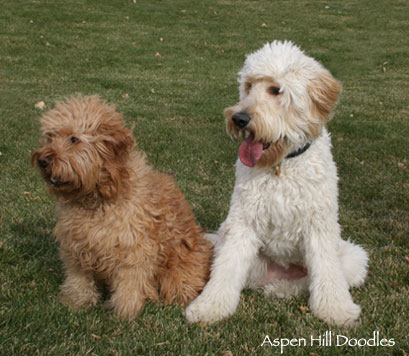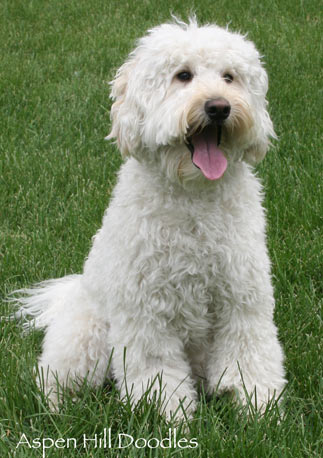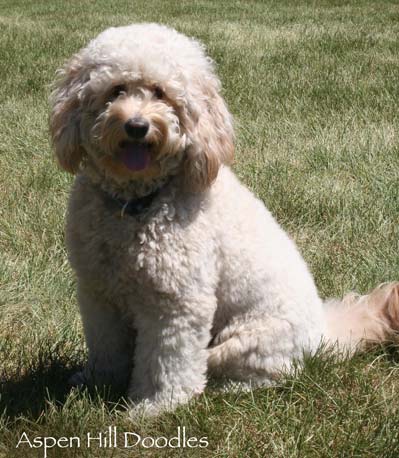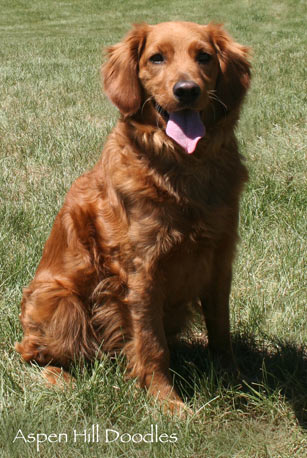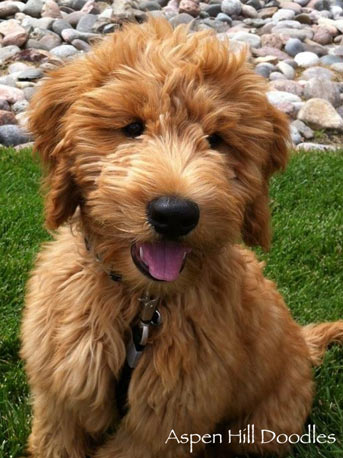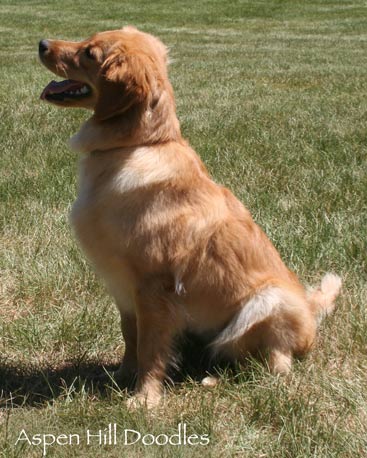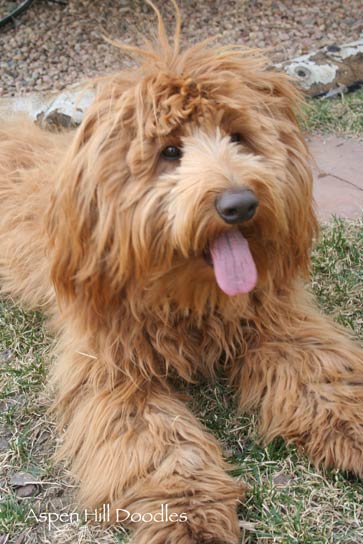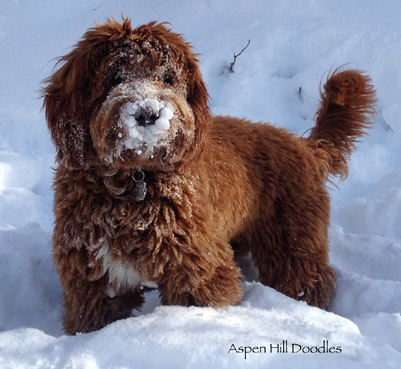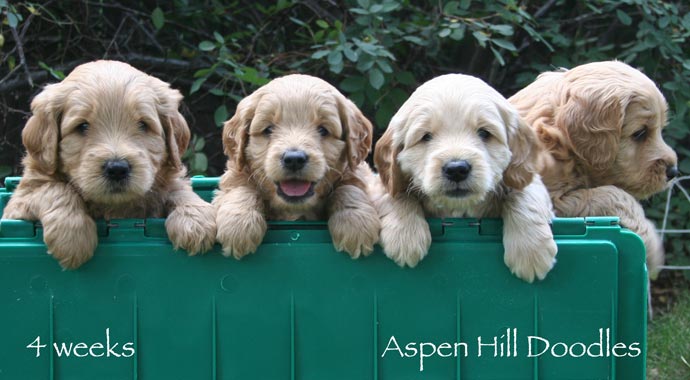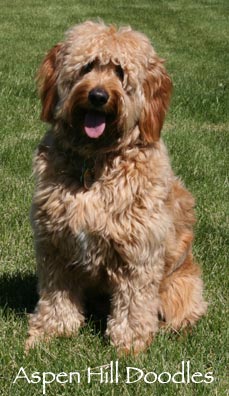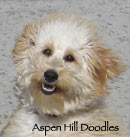
| Goldendoodles with sparkle, from Colorado |
|
|
|
|
|
|
|
|
|
|
What are they? A Goldendoodle is the dog born of a cross between a Golden Retriever and a Poodle. A Double Doodle is the cross between a Goldendoodle and a Labradoodle (Labradoodles are a cross between a Labrador and a Poodle). They are also known as "North American Retrievers". An Australian Double Doodle or an Australian Goldendoodle is the cross between a Goldendoodle and an Australian Labradoodle. An Australian Labradoodle is the cross between a Labrador, Poodle, and in some cases English and American Cocker Spaniels, Irish Water Spaniels, and Soft Coated Wheaten Terriers. Why are they? These breeds have been growing in popularity since the mid-1990's. They have what is known as "hybrid vigor". When two healthy dogs of different breeds are bred together the resulting puppies tend to be healthier (more vigorous) than either parent. This is because even with good breeding practices, purebred dogs are more likely to carry the same recessive genes which can lead to genetic disorders such as hip dysplasia. Also, in Goldendoodles, the combination of the calm, sweet golden retriever and the non-shedding, intelligent poodle creates what some have called the perfect dog. Combining a well bred Goldendoodle with a well bred Labradoodle also produces a wonderful, healthy dog. |
History First there were the Australian Labradoodles which were developed in Australia in the late 1980's as a service dog especially for people with allergies who couldn't have a Labrador due to their shedding. Golden Retriever lovers began developing the Goldendoodle in the mid-1990's, producing a soft and shaggy coated dog that has won people's hearts the world over. These dogs have joined the Labradoodle as being intelligent, competent, low to non-shedding working service dogs, and field dogs as well as family companions. At Aspen Hill Doodles, we began breeding Goldendoodles in 2005. We are one of the first reputable breeders of Goldendoodles in Colorado. We have developed several strong lines over the years. Grandparents and Great-grandparents etc. of current litters can be seen on our PARENT DOGS or RETIRED DOGS pages. What do they look like? Goldendoodles, Double Doodles and Australian Goldendoodles typically have a shaggy-dog look and can vary in color, size and coat quality. We call the look of this type of goldendoodle the "goldendoodle" type. In some generations, the pups look more like their Golden Retriever relatives (see our F1 Goldendoodle Retriever section), we call the look of this type of goldendoodle the "retriever" type. Types of Goldendoodles F1 Goldendoodles
F1B Goldendoodles F1B Goldendoodles will have a generally curlier coat than F1 Goldendoodles and are usually non-shedding. They are recommended for families with mild allergies to dogs. People who have moderate to severe allergies to dogs, would probably be safest getting a pure poodle.
F1 Goldendoodle Retrievers At Aspen Hill Doodles we do sometimes breed our F1B Goldendoodles back to Golden Retrievers. We call the pups F1 Goldendoodle Retrievers. They are considered first generation (F1) because one parent is one of the parent breeds. They are not called F1B because the name F1B is reserved for dogs where one parent is a Poodle. Because one parent is a Golden Retriever, the pups will be at least 50% Golden Retriever, probably more. When we select the F1B parent for an F1 Goldendoodle Retriever litter, we select a dog with many of the coat characteristics a poodle. We select a dog whose body build and temperament are similar to a Golden Retriever. Our F1 Goldendoodle Retrievers come in two types. The first type look very similar to Golden Retrievers, but they enjoy the hybrid vigor of Goldendoodles. The second type look very similar to wavy coated F1 Goldendoodles. We have found that the F1 Goldendoodle Retrievers that resemble Golden Retrievers (Retriever types) are just as likely to be low to non-shedding as their F1 Goldendoodle Retriever (Goldendoodle type) littermates.
F1B Goldendoodle Retriever is the cross between a F1 Goldendoodle Retriever and a Poodle. This cross goes back to the parent breed of Poodle, so we are able to use the "B" for backcross. The puppies from this cross will be very similar to a "regular" F1B Goldendoodle, although they may not be quite as curly and they may shed slightly more. Occasionally a litter of this generation will have both Goldendoodle type and Retriever type puppies (see F1 Goldendoodle Retrievers). F2 Goldendoodles Multigenerational Goldendoodles Types of Australian Goldendoodles (Double Doodles) F1 Australian Goldendoodles or F1 Australian Double Doodles
Size Goldendoodles that are 18 inches and under at the shoulder and under 30 pounds are called “minis” or Miniature Goldendoodles. Those that are about 18 to 21 inches at the shoulder and about 30 to 50 pounds are “mediums” or Medium Goldendoodles. Those that are above 21 inches at the shoulder and above 50 pounds are “standards” or Standard Goldendoodles.
|
||||||||||||||||||||||||
|
||||||||||||||||||||||||
Coat The coat of a Goldendoodle, Double Doodle, and Australian Goldendoodle is usually soft and curly and if left unclipped, it will usually grow from 4 to 7inches long (shorter on the face). How curly the coat is often depends on the type of cross of each particular Goldendoodle.
|
||||||||||||||||||||||||
Personality Goldendoodles, Double Doodles, and Australian Goldendoodles are happy, intelligent dogs that are friendly and loyal to their family. They get along well with children and other pets. They are happiest when they are with people. They love to learn and are easy to train. Maintenance Goldendoodles, Double Doodles, and Australian Goldendoodles require a moderate amount of exercise and grooming. |
||||||||||||||||||||||||
Home | Goldendoodles| Parent Dogs | Puppies | Photo Gallery | Guardian Homes |Visitors | Links | Contact Us | Retired Dogs Copyright © 2005 - 2023 Aspen Hill Doodles. All rights reserved.
Colorado
|
